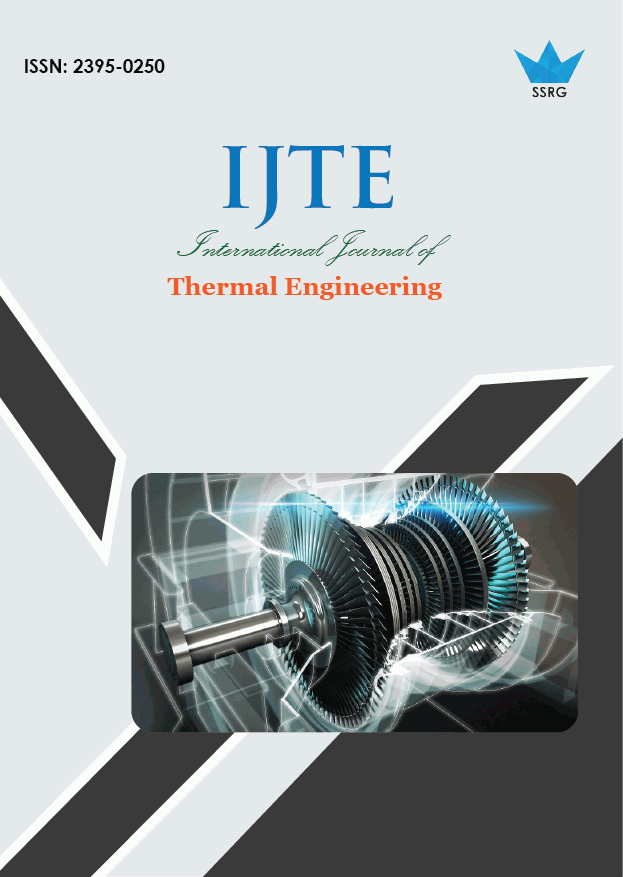Analysis of Heat Exchanger Pinch Point in a Waste-Heat Recovery SCO2 Rankine Cycle

| International Journal of Thermal Engineering |
| © 2015 by SSRG - IJTE Journal |
| Volume 1 Issue 3 |
| Year of Publication : 2015 |
| Authors : Kevin R. Anderson, Thomas Gross, Christopher McNamara |
How to Cite?
Kevin R. Anderson, Thomas Gross, Christopher McNamara, "Analysis of Heat Exchanger Pinch Point in a Waste-Heat Recovery SCO2 Rankine Cycle," SSRG International Journal of Thermal Engineering, vol. 1, no. 3, pp. 22-26, 2015. Crossref, https://doi.org/10.14445/23950250/IJTE-V1I6P102
Abstract:
It has recently been recognized that a large quantity of waste heat is generated annually, and thus represents a large opportunity for energy savings. With burgeoning research in cycles which utilize super critical carbon dioxide as a unique organic working fluid. This paper focuses on the analysis of a heat exchanger for use in conjunction with a Supercritical CO2 (SCO2) Rankine low grade waste-heat energy recovery cycle. The NTU- method is used to design the heat exchanger. Porous media flow is used for heat transfer augmentation on the tube side of the heat exchanger. Second law analysis has been used to place a practical limitation on the results of pinch point versus heat exchanger area published in this study.
Keywords:
Supercritical CO2, Heat Exchanger, Exergy, Renewable Energy, Porous Media Flow.
References:
[1] K. Anderson, M. Devost, T. Wells, D. Forgette, R. Okerson, M. Stuart, and S. Cunningham, "Waste heat energy regenerative supercritical carbon dioxide (SCO2) Rankine cycle thermodynamic analysis and design, Advances in Renewable Energy, vol. 1, pp. 1- 10, April, 2014.
[2] K. Anderson, C. McNamara, J. Henriquez, A. Hernandez, K. Dapkunas, E. Park, B. Kobeissi, and J. Wells, ―Mechanical Design and Analysis of a SCO2 Renewable Energy Cycle Expansion Engine," Trends in Machine Design, vol. 1, issue 3, pp. 10-25, December, 2014.
[3] E. Thanigaivelan and N. Gupta, ―Thermal Study of Transfer in an Exchanger Made up of Two Cylindrical Tubes, SSRG Intl. Journal of Thermal Engineering, vol. 1, issue 1, pp. 21-25, Jan. 2015.
[4] Pal Durgeshkumar, K. and S. Umale, ―Numerical Investigation on Air Side Performance of Fin and Tube Heat Exchangers with Different Types of Fins, SSRG Intl. Journal of Thermal Engineering, vol. 1, issue 2 , pp. 1-7, Apr. 2015.
[5] A. Reddy and P.S. Rao, ―Design and Analysis Based on the Simulation Reports of an Existing Heat Exchanger, SSRG Intl. Journal of Mechanical Engineering, vol. 1, issue 5 , pp. 8-13, Sep. 2014.
[6] F. P. Incropera and D. P. DeWitt, Fundamentals of Heat and Mass Transfer, 4th Ed. , New York: Wiley, 1996.
[7] Kreith, F., Principles of Heat Transfer, Scranton: International Textbook Co., 1958.
[8] E. W. Lemmon, M.L. Huber, and M.O. McLinden ―NIST Standard Reference Database 23: Reference Fluid Thermodynamic and Transport Properties-REFPROP, National Institute of Standards and Technology, Standard Reference Data Program, Version 9.0.
[9] T. Kuppan, Heat Exchanger Design Handbook T., 1st Ed., Dekker, 2000.
[10] R.K. Shah and D.P. Sekulic, Handbook of Heat Transfer, New York: McGraw-Hill, 1998.
[11] H. Liu, Heat Exchangers, Rating, and Thermal Design Liu, 2nd ed., Boca Raton: CRC, 2002.
[12] M. Hammad, A.S. Alshqirate, and M. Tarawneh, ―Cooling of superheated refrigerants flowing inside tubes filled with porous media: study of heat transfer and pressure drop, carbon dioxide case study, Journal of Energy and Power Engineering, vol. 5, pp. 802- 810, 2011.
[13] Y.A. Cengel and M. A. Boles, Thermodynamics, New York: McGraw Hill, 2010.
[14] K. Manjunath and S.C. Kaushik ―Second law thermodynamic study of heat exchangers: a review Renewable and Sustainable Energy Reviews, vol. 40, pp. 348-374, 2014.

 10.14445/23950250/IJTE-V1I6P102
10.14445/23950250/IJTE-V1I6P102